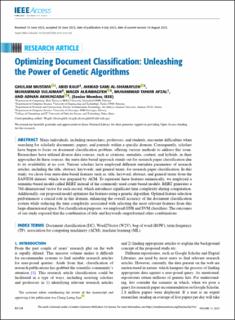| dc.identifier.citation | Mustafa, G., Rauf, A., Al-Shamayleh, A. S., Sulaiman, M., Alrawagfeh, W., Afzal, M. T., & Akhunzada, A. (2023). Optimizing document classification: Unleashing the power of genetic algorithms. IEEE Access. | en_US |
| dc.description.abstract | Many individuals, including researchers, professors, and students, encounter difficulties when searching for scholarly documents, papers, and journals within a specific domain. Consequently, scholars have begun to focus on document classification problem, offering various methods to address this issue. Researchers have utilized diverse data sources, such as citations, metadata, content, and hybrids, in their approaches.In these sources, the meta-data-based approach stands out for research paper classification due to its availability at no cost. Various scholars have employed different metadata parameters of research articles, including the title, abstract, keywords, and general terms, for research paper classification. In this study, we chose four meta-data-based features such as, title, keyword, abstract, and general terms from the SANTOS dataset, which was prepared by ACM. To represent these features numerically, we employed a semantic-based model called BERT instead of the commonly used count-based models. BERT generates a 768-dimensional vector for each record, which introduces significant time complexity during computation. Additionally, our proposed model optimizes the features using a genetic algorithm. Optimal feature selection performances a crucial role in this domain, enhancing the overall accuracy of the document classification system while reducing the time complexity associated with selecting the most relevant features from this large-dimensional space. For classification purposes, we employed GNB and SVM classifiers. The outcomes of our study exposed that the combination of title and keywords outperformed other combinations. | en_US |

